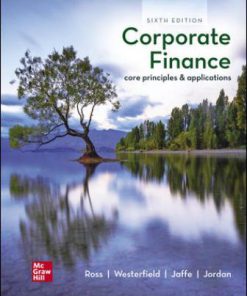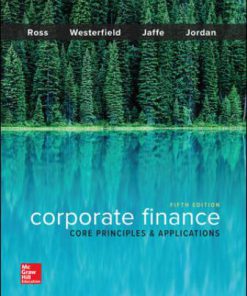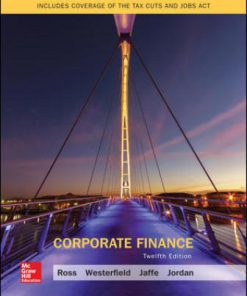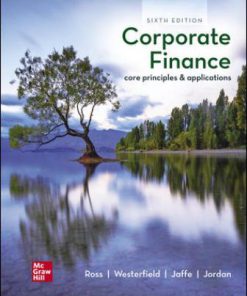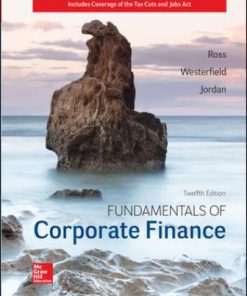Test Bank for Fundamentals of Corporate Finance 10th edition. Stephen A. Ross, Randolph W. Westerfield, Bradford D. Jordan
$35.00 Original price was: $35.00.$26.50Current price is: $26.50.
Test Bank for Fundamentals of Corporate Finance 10th edition. Stephen A. Ross, Randolph W. Westerfield, Bradford D. Jordan
This is completed downloadable of Test Bank for Fundamentals of Corporate Finance 10th edition. Stephen A. Ross, Randolph W. Westerfield, Bradford D. Jordan
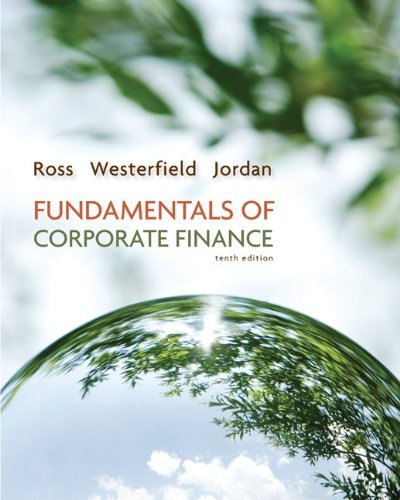
Product Details:
- ISBN-10 : 0077479459
- ISBN-13 : 978-0077479459
- Author: Stephen A. Ross, Randolph W. Westerfield, Bradford D. Jordan
Now in a Tenth Canadian Edition, Ross Fundamentals of Corporate Finance continues its tradition of excellence as a market leader. Known for its approach, Ross focuses on three powerful ideas which are integrated throughout — emphasis on intuition, unified valuation approach, and managerial emphasis giving students a solid foundation in business and finance. The Tenth Edition has been updated to provide current, real world examples, and a wealth of new problem material.
Table of Content:
- PART 1 Overview of Corporate Finance
- CHAPTER 1 Introduction to Corporate Finance
- 1.1 Corporate Finance and the Financial Manager
- What Is Corporate Finance?
- The Financial Manager
- Financial Management Decisions
- 1.2 Forms of Business Organization
- Sole Proprietorship
- Partnership
- Corporation
- Income Trust
- Co-operative (Co-op)
- 1.3 The Goal of Financial Management
- Possible Goals
- The Goal of Financial Management
- A More General Goal
- 1.4 The Agency Problem and Control of the Corporation
- Agency Relationships
- Management Goals
- Do Managers Act in the Shareholders’ Interests?
- Corporate Social Responsibility and Ethical Investing
- 1.5 Financial Markets and the Corporation
- Cash Flows to and from the Firm
- Money versus Capital Markets
- Primary versus Secondary Markets
- 1.6 Financial Institutions
- 1.7 Trends in Financial Markets and Financial Management
- 1.8 Outline of the Text
- Summary and Conclusions
- CHAPTER 2 Financial Statements, Cash Flow, and Taxes
- 2.1 Statement of Financial Position
- Assets
- Liabilities and Owners’ Equity
- Net Working Capital
- Liquidity
- Debt versus Equity
- Value versus Cost
- 2.2 Statement of Comprehensive Income
- International Financial Reporting Standards (IFRS)
- Non-Cash Items
- Time and Costs
- 2.3 Cash Flow
- Cash Flow from Assets
- Cash Flow to Creditors and Shareholders
- 2.4 Taxes
- Individual Tax Rates
- Average versus Marginal Tax Rates
- Taxes on Investment Income
- Corporate Taxes
- Taxable Income
- Global Tax Rates
- Capital Gains and Carry-Forward and Carry-Back
- 2.5 Capital Cost Allowance
- Asset Purchases and Sales
- Summary and Conclusions
- PART 2 Financial Statements and Long-Term Financial Planning
- CHAPTER 3 Working with Financial Statements
- 3.1 Cash Flow and Financial Statements: A Closer Look
- Sources and Uses of Cash
- Statement of Cash Flows
- 3.2 Standardized Financial Statements
- Common-Size Statements
- Common–Base Year Financial Statements: Trend Analysis
- 3.3 Ratio Analysis
- Short-Term Solvency or Liquidity Measures
- Other Liquidity Ratios
- Long-Term Solvency Measures
- Asset Management, or Turnover, Measures
- Profitability Measures
- Market Value Measures
- 3.4 The DuPont Identity
- 3.5 Using Financial Statement Information
- Why Evaluate Financial Statements?
- Choosing a Benchmark
- Problems with Financial Statement Analysis
- Summary and Conclusions
- CHAPTER 4 Long-Term Financial Planning and Corporate Growth
- 4.1 What Is Financial Planning?
- Growth as a Financial Management Goal
- Dimensions of Financial Planning
- What Can Planning Accomplish?
- 4.2 Financial Planning Models: A First Look
- A Financial Planning Model: The Ingredients
- A Simple Financial Planning Model
- 4.3 The Percentage of Sales Approach
- An Illustration of the Percentage of Sales Approach
- 4.4 External Financing and Growth
- External Financing Needed and Growth
- Internal Growth Rate
- Financial Policy and Growth
- Determinants of Growth
- A Note on Sustainable Growth Rate Calculations
- 4.5 Some Caveats on Financial Planning Models
- Summary and Conclusions
- PART 3 Valuation of Future Cash Flows
- CHAPTER 5 Introduction to Valuation: The Time Value of Money
- 5.1 Future Value and Compounding
- Investing for a Single Period
- Investing for More than One Period
- A Note on Compound Growth
- 5.2 Present Value and Discounting
- The Single-Period Case
- Present Values for Multiple Periods
- 5.3 More on Present and Future Values
- Present versus Future Value
- Determining the Discount Rate
- Finding the Number of Periods
- Summary and Conclusions
- CHAPTER 6 Discounted Cash Flow Valuation
- 6.1 Future and Present Values of Multiple Cash Flows
- Future Value with Multiple Cash Flows
- Present Value with Multiple Cash Flows
- A Note on Cash Flow Timing
- 6.2 Valuing Annuities and Perpetuities
- Present Value for Annuity Cash Flows
- Future Value for Annuities
- A Note on Annuities Due
- Perpetuities
- Growing Perpetuities
- Formula for Present Value of Growing Perpetuity
- Growing Annuity
- Formula for Present Value of Growing Annuity
- 6.3 Comparing Rates: The Effect of Compounding
- Effective Annual Rates and Compounding
- Calculating and Comparing Effective Annual Rates
- Mortgages
- EARs and APRs
- Taking It to the Limit: A Note on Continuous Compounding
- 6.4 Loan Types and Loan Amortization
- Pure Discount Loans
- Interest-Only Loans
- Amortized Loans
- Summary and Conclusions
- Appendix 6A: Proof of Annuity Present Value Formula
- CHAPTER 7 Interest Rates and Bond Valuation
- 7.1 Bonds and Bond Valuation
- Bond Features and Prices
- Bond Values and Yields
- Interest Rate Risk
- Finding the Yield to Maturity
- 7.2 More on Bond Features
- Is It Debt or Equity?
- Long-Term Debt: The Basics
- The Indenture
- 7.3 Bond Ratings
- 7.4 Some Different Types of Bonds
- Financial Engineering
- Stripped Bonds
- Floating-Rate Bonds
- Other Types of Bonds
- 7.5 Bond Markets
- How Bonds Are Bought and Sold
- Bond Price Reporting
- A Note on Bond Price Quotes
- Bond Funds
- Bonds and Restructuring
- 7.6 Inflation and Interest Rates
- Real versus Nominal Rates
- The Fisher Effect
- Inflation and Present Values
- 7.7 Determinants of Bond Yields
- The Term Structure of Interest Rates
- Bond Yields and the Yield Curve: Putting It All Together
- Conclusion
- Summary and Conclusions
- Appendix 7A: Managing Interest Rate Risk
- CHAPTER 8 Stock Valuation
- 8.1 Common Stock Valuation
- Common Stock Cash Flows
- Common Stock Valuation: Some Special Cases
- Changing the Growth Rate
- Components of the Required Return
- 8.2 Common Stock Features
- Shareholders’ Rights
- Dividends
- Classes of Stock
- 8.3 Preferred Stock Features
- Stated Value
- Cumulative and Non-Cumulative Dividends
- Is Preferred Stock Really Debt?
- Preferred Stock and Taxes
- Beyond Taxes
- 8.4 Stock Market Reporting
- Growth Opportunities
- Application: The Price–Earnings Ratio
- Summary and Conclusions
- Appendix 8A: Corporate Voting
- PART 4 Capital Budgeting
- CHAPTER 9 Net Present Value and Other Investment Criteria
- 9.1 Net Present Value
- The Basic Idea
- Estimating Net Present Value
- 9.2 The Payback Rule
- Defining the Rule
- Analyzing the Payback Period Rule
- Redeeming Qualities
- Summary of the Rule
- The Discounted Payback Rule
- 9.3 The Average Accounting Return
- Analyzing the Average Accounting Return Method
- 9.4 The Internal Rate of Return
- Problems with the IRR
- Redeeming Qualities of the IRR
- 9.5 The Profitability Index
- 9.6 The Practice of Capital Budgeting
- 9.7 Capital Rationing
- Summary and Conclusions
- Appendix 9A: The Modified Internal Rate of Return
- CHAPTER 10 Making Capital Investment Decisions
- 10.1 Project Cash Flows: A First Look
- Relevant Cash Flows
- The Stand-Alone Principle
- 10.2 Incremental Cash Flows
- Sunk Costs
- Opportunity Costs
- Side Effects
- Net Working Capital
- Financing Costs
- Inflation
- Capital Budgeting and Business Taxes in Canada
- Other Issues
- 10.3 Pro Forma Financial Statements and Project Cash Flows
- Getting Started: Pro Forma Financial Statements
- Project Cash Flows
- Project Total Cash Flow and Value
- 10.4 More on Project Cash Flow
- A Closer Look at Net Working Capital
- Depreciation and Capital Cost Allowance
- An Example: The Majestic Mulch and Compost Company (MMCC)
- 10.5 Alternative Definitions of Operating Cash Flow
- The Bottom-up Approach
- The Top-down Approach
- The Tax Shield Approach
- Conclusion
- 10.6 Applying the Tax Shield Approach to the Majestic Mulch and Compost Company Project
- Present Value of the Tax Shield on CCA
- Salvage Value versus UCC
- 10.7 Some Special Cases of Discounted Cash Flow Analysis
- Evaluating Cost-Cutting Proposals
- Replacing an Asset
- Evaluating Equipment with Different Lives
- Setting the Bid Price
- Summary and Conclusions
- Appendix 10A: More on Inflation and Capital Budgeting
- Appendix 10B: Capital Budgeting with Spreadsheets
- Appendix 10C: Deriving the Tax Shield on CCA Formula
- CHAPTER 11 Project Analysis and Evaluation
- 11.1 Evaluating NPV Estimates
- The Basic Problem
- Projected versus Actual Cash Flows
- Forecasting Risk
- Sources of Value
- 11.2 Scenario and Other What-If Analyses
- Getting Started
- Scenario Analysis
- Sensitivity Analysis
- Simulation Analysis
- 11.3 Break-Even Analysis
- Fixed and Variable Costs
- Accounting Break-Even
- Accounting Break-Even: A Closer Look
- Uses for the Accounting Break-Even
- 11.4 Operating Cash Flow, Sales Volume, and Break-Even
- Accounting Break-Even and Cash Flow
- Cash Flow and Financial Break-Even Points
- 11.5 Operating Leverage
- The Basic Idea
- Implications of Operating Leverage
- Measuring Operating Leverage
- Operating Leverage and Break-Even
- 11.6 Managerial Options
- Summary and Conclusions
- PART 5 Risk and Return
- CHAPTER 12 Lessons from Capital Market History
- 12.1 Returns
- Dollar Returns
- Percentage Returns
- 12.2 The Historical Record
- A First Look
- A Closer Look
- 12.3 Average Returns: The First Lesson
- Calculating Average Returns
- Average Returns: The Historical Record
- Risk Premiums
- The First Lesson
- 12.4 The Variability of Returns: The Second Lesson
- Frequency Distributions and Variability
- The Historical Variance and Standard Deviation
- The Historical Record
- Normal Distribution
- Value at Risk
- The Second Lesson
- 2008: The Bear Growled and Investors Howled
- Using Capital Market History
- 12.5 More on Average Returns
- Arithmetic versus Geometric Averages
- Calculating Geometric Average Returns
- Arithmetic Average Return or Geometric Average Return?
- 12.6 Capital Market Efficiency
- Price Behaviour in an Efficient Market
- The Efficient Markets Hypothesis
- Market Efficiency—Forms and Evidence
- Summary and Conclusions
- CHAPTER 13 Return, Risk, and the Security Market Line
- 13.1 Expected Returns and Variances
- Expected Return
- Calculating the Variance
- 13.2 Portfolios
- Portfolio Weights
- Portfolio Expected Returns
- Portfolio Variance
- Portfolio Standard Deviation and Diversification
- The Efficient Set
- Correlations in the Financial Crisis of 2007–2009
- 13.3 Announcements, Surprises, and Expected Returns
- Expected and Unexpected Returns
- Announcements and News
- 13.4 Risk: Systematic and Unsystematic
- Systematic and Unsystematic Risk
- Systematic and Unsystematic Components of Return
- 13.5 Diversification and Portfolio Risk
- The Effect of Diversification: Another Lesson from Market History
- The Principle of Diversification
- Diversification and Unsystematic Risk
- Diversification and Systematic Risk
- Risk and the Sensible Investor
- 13.6 Systematic Risk and Beta
- The Systematic Risk Principle
- Measuring Systematic Risk
- Portfolio Betas
- 13.7 The Security Market Line
- Beta and the Risk Premium
- Calculating Beta
- The Security Market Line
- 13.8 Arbitrage Pricing Theory and Empirical Models
- Appendix 13A: Derivation of the Capital Asset Pricing Model
- Summary and Conclusions
- PART 6 Cost of Capital and Long-Term Financial Policy
- CHAPTER 14 Cost of Capital
- 14.1 The Cost of Capital: Some Preliminaries
- Required Return versus Cost of Capital
- Financial Policy and Cost of Capital
- 14.2 The Cost of Equity
- The Dividend Growth Model Approach
- The SML Approach
- The Cost of Equity in Rate Hearings
- 14.3 The Costs of Debt and Preferred Stock
- The Cost of Debt
- The Cost of Preferred Stock
- 14.4 The Weighted Average Cost of Capital
- The Capital Structure Weights
- Taxes and the Weighted Average Cost of Capital
- Solving the Warehouse Problem and Similar Capital Budgeting Problems
- Performance Evaluation: Another Use of the WACC
- 14.5 Divisional and Project Costs of Capital
- The SML and the WACC
- Divisional Cost of Capital
- The Pure Play Approach
- The Subjective Approach
- 14.6 Company Valuation with the WACC
- 14.7 Flotation Costs and the Weighted Average Cost of Capital
- The Basic Approach
- Flotation Costs and NPV
- Internal Equity and Flotation Costs
- 14.8 Calculating WACC for Loblaw
- Estimating Financing Proportions
- Market Value Weights for Loblaw
- Cost of Debt
- Cost of Preferred Shares
- Cost of Common Stock
- CAPM
- Dividend Valuation Model Growth Rate
- Loblaw’s WACC
- Summary and Conclusions
- Appendix 14A: Adjusted Present Value
- Appendix 14B: Economic Value Added and the Measurement of Financial Performance
- CHAPTER 15 Raising Capital
- 15.1 The Financing Life Cycle of a Firm: Early-Stage Financing and Venture Capital
- Venture Capital
- Some Venture Capital Realities
- Choosing a Venture Capitalist
- Conclusion
- 15.2 The Public Issue
- 15.3 The Basic Procedure for a New Issue
- Securities Registration
- Exempt Securities and Crowd funding
- Alternative Issue Methods
- 15.4 The Cash Offer
- Types of Underwriting
- Bought Deal
- Dutch Auction Underwriting
- The Selling Period
- The Overallotment Option
- Lockup Agreements
- The Quiet Periods
- The Investment Dealers
- 15.5 IPOs and Underpricing
- IPO Underpricing: The 1999–
- Experience
- Evidence on Underpricing
- Why Does Underpricing Exist?
- 15.6 New Equity Sales and the Value of the Firm
- 15.7 The Cost of Issuing Securities
- IPOs in Practice: The Case of Seven Generations Energy
- 15.8 Rights
- The Mechanics of a Rights Offering
- Number of Rights Needed to Purchase a Share
- The Value of a Right
- Theoretical Value of a Right
- Ex Rights
- Value of Rights after Ex-Rights Date
- The Underwriting Arrangements
- Effects on Shareholders
- Cost of Rights Offerings
- 15.9 Dilution
- Dilution of Proportionate Ownership
- Dilution of Value: Book versus Market Values
- 15.10 Issuing Long-Term Debt
- Summary and Conclusions
- CHAPTER 16 Financial Leverage and Capital Structure Policy
- 16.1 The Capital Structure Question
- Firm Value and Stock Value: An Example
- Capital Structure and the Cost of Capital
- 16.2 The Effect of Financial Leverage
- The Basics of Financial Leverage
- Corporate Borrowing and Homemade Leverage
- 16.3 Capital Structure and the Cost of Equity Capital
- M&M Proposition I: The Pie Model
- The Cost of Equity and Financial Leverage: M&M Proposition II
- Business and Financial Risk
- 16.4 M&M Propositions I and II with Corporate Taxes
- The Interest Tax Shield
- Taxes and M&M Proposition I
- Taxes, the WACC, and Proposition II
- 16.5 Bankruptcy Costs
- Direct Bankruptcy Costs
- Indirect Bankruptcy Costs
- Agency Costs of Equity
- 16.6 Optimal Capital Structure
- The Static Theory of Capital Structure
- Optimal Capital Structure and the Cost of Capital
- Optimal Capital Structure: A Recap
- Capital Structure: Some Managerial Recommendations
- 16.7 The Pie Again
- The Extended Pie Model
- Marketed Claims versus Non-Marketed Claims
- 16.8 The Pecking-Order Theory
- Internal Financing and the Pecking Order
- Implications of the Pecking Order
- 16.9 Observed Capital Structures
- 16.10 Long-Term Financing under Financial Distress and Bankruptcy
- Liquidation and Reorganization
- Agreements to Avoid Bankruptcy
- Summary and Conclusions
- Appendix 16A: Capital Structure and Personal Taxes
- Appendix 16B: Derivation of Proposition II (Equation 16.4)
- CHAPTER 17 Dividends and Dividend Policy
- 17.1 Cash Dividends and Dividend Payment
- Cash Dividends
- Standard Method of Cash Dividend Payment
- Dividend Payment: A Chronology
- More on the Ex-Dividend Date
- 17.2 Does Dividend Policy Matter?
- An Illustration of the Irrelevance of Dividend Policy
- 17.3 Real-World Factors Favouring a Low Payout
- Taxes
- Some Evidence on Dividends and Taxes in Canada
- Flotation Costs
- Dividend Restrictions
- 17.4 Real-World Factors Favouring a High Payout
- Desire for Current Income
- Uncertainty Resolution
- Tax and Legal Benefits from High Dividends
- Conclusion
- 17.5 A Resolution of Real-World Factors?
- Information Content of Dividends
- Dividend Signalling in Practice
- The Clientele Effect
- 17.6 Establishing a Dividend Policy
- Residual Dividend Approach
- Dividend Stability
- A Compromise Dividend Policy
- Some Survey Evidence on Dividends
- 17.7 Stock Repurchase: An Alternative to Cash Dividends
- Cash Dividends versus Repurchase
- Real-World Considerations in a Repurchase
- Share Repurchase and EPS
- 17.8 Stock Dividends and Stock Splits
- Some Details on Stock Splits and Stock Dividends
- Value of Stock Splits and Stock Dividends
- Reverse Splits
- Summary and Conclusions
- PART 7 Short-Term Financial Planning and Management
- CHAPTER 18 Short-Term Finance and Planning
- 18.1 Tracing Cash and Net Working Capital
- 18.2 The Operating Cycle and the Cash Cycle
- Defining the Operating and Cash Cycles
- Calculating the Operating and Cash Cycles
- Interpreting the Cash Cycle
- 18.3 Some Aspects of Short-Term Financial Policy
- The Size of the Firm’s Investment in Current Assets
- Alternative Financing Policies for Current Assets
- Which Financing Policy Is Best?
- Current Assets and Liabilities in Practice
- 18.4 The Cash Budget
- Sales and Cash Collections
- Cash Outflows
- The Cash Balance
- 18.5 A Short-Term Financial Plan
- Short-Term Planning and Risk
- 18.6 Short-Term Borrowing
- Operating Loans
- Letters of Credit
- Secured Loans
- Factoring
- Securitized Receivables—A Financial Innovation
- Inventory Loans
- Trade Credit
- Money Market Financing
- Summary and Conclusions
- CHAPTER 19 Cash and Liquidity Management
- 19.1 Reasons for Holding Cash
- Speculative and Precautionary Motives
- The Transaction Motive
- Costs of Holding Cash
- Cash Management versus Liquidity Management
- 19.2 Determining the Target Cash Balance
- The Basic Idea
- Other Factors Influencing the Target Cash Balance
- 19.3 Understanding Float
- Disbursement Float
- Collection Float and Net Float
- Float Management
- Accelerating Collections
- Over-the-Counter Collections
- Controlling Disbursements
- 19.4 Investing Idle Cash
- Temporary Cash Surpluses
- Characteristics of Short-Term Securities
- Some Different Types of Money Market Securities
- Summary and Conclusions
- CHAPTER 20 Credit and Inventory Management
- 20.1 Credit and Receivables
- Components of Credit Policy
- The Cash Flows from Granting Credit
- The Investment in Receivables
- 20.2 Terms of the Sale
- Why Trade Credit Exists
- The Basic Form
- The Credit Period
- Cash Discounts
- Credit Instruments
- 20.3 Analyzing Credit Policy
- Credit Policy Effects
- Evaluating a Proposed Credit Policy
- 20.4 Optimal Credit Policy
- The Total Credit Cost Curve
- Organizing the Credit Function
- 20.5 Credit Analysis
- When Should Credit Be Granted?
- Credit Information
- Credit Evaluation and Scoring
- 20.6 Collection Policy
- Monitoring Receivables
- Collection Effort
- Credit Management in Practice
- 20.7 Inventory Management
- The Financial Manager and Inventory Policy
- Inventory Types
- Inventory Costs
- 20.8 Inventory Management Techniques
- The ABC Approach
- The Economic Order Quantity (EOQ) Model
- Extensions to the EOQ Model
- Managing Derived-Demand Inventories
- Materials Requirements Planning (MRP)
- Just-In-Time Inventory
- Summary and Conclusions
- PART 8 Topics in Corporate Finance
- CHAPTER 21 International Corporate Finance
- 21.1 Terminology
- 21.2 Foreign Exchange Markets and Exchange Rates
- Exchange Rates
- Types of Transactions
- 21.3 Purchasing Power Parity
- Absolute Purchasing Power Parity
- Relative Purchasing Power Parity
- Currency Appreciation and Depreciation
- 21.4 Interest Rate Parity, Unbiased Forward Rates, and the Generalized Fisher Effect
- Covered Interest Arbitrage
- Interest Rate Parity (IRP)
- Forward Rates and Future Spot Rates
- Putting It All Together
- 21.5 International Capital Budgeting
- Method 1: The Home Currency Approach
- Method 2: The Foreign Currency Approach
- Unremitted Cash Flows
- 21.6 Financing International Projects
- The Cost of Capital for International Firms
- International Diversification and Investors
- Sources of Short- and Intermediate-Term Financing
- 21.7 Exchange Rate Risk
- Transaction Exposure
- Economic Exposure
- Translation Exposure
- Managing Exchange Rate Risk
- 21.8 Political and Governance Risks
- Corporate Governance Risk
- Summary and Conclusions
- CHAPTER 22 Leasing
- 22.1 Leases and Lease Types
- Leasing versus Buying
- Operating Leases
- Financial Leases
- 22.2 Accounting and Leasing
- 22.3 Taxes, Canada Revenue Agency (CRA), and Leases
- 22.4 The Cash Flows from Leasing
- The Incremental Cash Flows
- 22.5 Lease or Buy?
- A Preliminary Analysis
- NPV Analysis
- A Misconception
- Asset Pool and Salvage Value
- 22.6 A Leasing Paradox
- Resolving the Paradox
- Leasing and Capital Budgeting
- 22.7 Reasons for Leasing
- Good Reasons for Leasing
- Bad Reasons for Leasing
- Other Reasons for Leasing
- Leasing Decisions in Practice
- Summary and Conclusions
- CHAPTER 23 Mergers and Acquisitions
- 23.1 The Legal Forms of Acquisitions
- Merger or Consolidation
- Acquisition of Stock
- Acquisition of Assets
- Acquisition Classifications
- A Note on Takeovers
- Alternatives to Merger
- 23.2 Taxes and Acquisitions
- Determinants of Tax Status
- Taxable versus Tax-Free Acquisitions
- 23.3 Accounting for Acquisitions
- 23.4 Gains from Acquisition
- Synergy
- Revenue Enhancement
- Cost Reductions
- Tax Gains
- Changing Capital Requirements
- Avoiding Mistakes
- A Note on Inefficient Management and Opportunistic Takeover Offers
- The Negative Side of Takeovers
- 23.5 Some Financial Side-Effects of Acquisitions
- Earnings Per Share (EPS) Growth
- Diversification
- 23.6 The Cost of an Acquisition
- Case I: Cash Acquisition
- Case II: Stock Acquisition
- Cash versus Common Stock
- 23.7 Defensive Tactics
- The Control Block and the Corporate Charter
- Repurchase /Standstill Agreements
- Exclusionary Offers and Dual-Class Stock
- Share Rights Plans
- Going Private and Leveraged Buyouts
- LBOs to Date: The Record
- Other Defensive Devices and Jargon of Corporate Takeovers
- 23.8 Some Evidence on Acquisitions
- 23.9 Divestitures and Restructurings
- Summary and Conclusions
- PART 9 Derivative Securities and Corporate Finance
- CHAPTER 24 Enterprise Risk Management
- 24.1 Insurance
- 24.2 Managing Financial Risk
- The Impact of Financial Risk: The Credit Crisis of 2007–09
- The Risk Profile
- Reducing Risk Exposure
- Hedging Short-Term Exposure
- Cash Flow Hedging: A Cautionary Note
- Hedging Long-Term Exposure
- Conclusion
- 24.3 Hedging with Forward Contracts
- Forward Contracts: The Basics
- The Payoff Profile
- Hedging with Forwards
- 24.4 Hedging with Futures Contracts
- Trading in Futures
- Futures Exchanges
- Hedging with Futures
- 24.5 Hedging with Swap Contracts
- Currency Swaps
- Interest Rate Swaps
- Commodity Swaps
- The Swap Dealer
- Interest Rate Swaps: An Example
- Credit Default Swaps (CDS)
- 24.6 Hedging with Option Contracts
- Option Terminology
- Options versus Forwards
- Option Payoff Profiles
- Option Hedging
- Hedging Commodity Price Risk with Options
- Hedging Exchange Rate Risk with Options
- Hedging Interest Rate Risk with Options
- Actual Use of Derivatives
- Summary and Conclusions
- CHAPTER 25 Options and Corporate Securities
- 25.1 Options: The Basics
- Puts and Calls
- Stock Option Quotations
- Option Payoffs
- Put Payoffs
- Long-Term Options
- 25.2 Fundamentals of Option Valuation
- Value of a Call Option at Expiration
- The Upper and Lower Bounds on a Call Option’s Value
- A Simple Model: Part I
- Four Factors Determining Option Values
- 25.3 Valuing a Call Option
- A Simple Model: Part II
- The Fifth Factor
- A Closer Look
- 25.4 Employee Stock Options
- ESO Features
- ESO Repricing
- 25.5 Equity as a Call Option on the Firm’s Assets
- Case I: The Debt Is Risk-Free
- Case II: The Debt Is Risky
- 25.6 Warrants
- The Difference between Warrants and Call Options
- Warrants and the Value of the Firm
- 25.7 Convertible Bonds
- Features of a Convertible Bond
- Value of a Convertible Bond
- 25.8 Reasons for Issuing Warrants and Convertibles
- The Free Lunch Story
- The Expensive Lunch Story
- A Reconciliation
- 25.9 Other Options
- The Call Provision on a Bond
- Put Bonds
- The Overallotment Option
- Insurance and Loan Guarantees
- Managerial Options
- Summary and Conclusions
- Appendix 25A: The Black–Scholes Option Pricing Model
- CHAPTER 26 Behavioural Finance: Implications for Financial Management
- 26.1 Introduction to Behavioural Finance
- 26.2 Biases
- Overconfidence
- Overoptimism
- Confirmation Bias
- 26.3 Framing Effects
- Loss Aversion
- House Money
- 26.4 Heuristics
- The Affect Heuristic
- The Representativeness Heuristic
- Representativeness and Randomness
- The Gambler’s Fallacy
- 26.5 Behavioural Finance and Market Efficiency
- Limits to Arbitrage
- Bubbles and Crashes
- 26.6 Market Efficiency and the Performance of Professional Money Managers
- Summary and Conclusions
- Glossary
People Also Search:
fundamentals of corporate finance
fundamentals of corporate finance 10th edition
fundamentals of corporate finance 10th edition download scribd
fundamentals of corporate finance 10th edition test bank download pdf
fundamentals of corporate finance 10th edition answer key
You may also like…
Solution Manual
Solution Manual
Solution Manual




